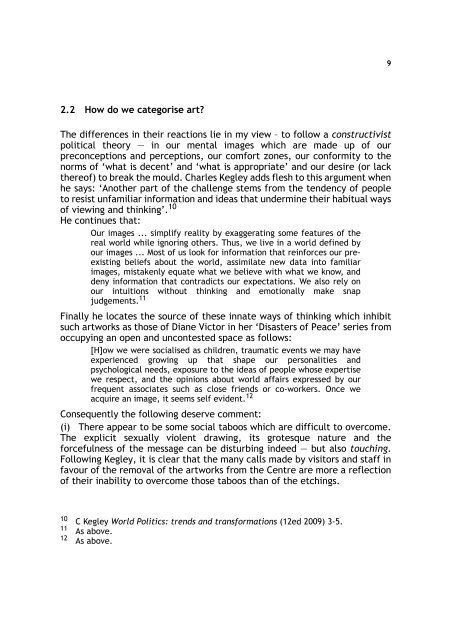Download this publication - PULP - University of Pretoria
Download this publication - PULP - University of Pretoria
Download this publication - PULP - University of Pretoria
Create successful ePaper yourself
Turn your PDF publications into a flip-book with our unique Google optimized e-Paper software.
2.2 How do we categorise art?<br />
The differences in their reactions lie in my view – to follow a constructivist<br />
political theory — in our mental images which are made up <strong>of</strong> our<br />
preconceptions and perceptions, our comfort zones, our conformity to the<br />
norms <strong>of</strong> ‘what is decent’ and ‘what is appropriate’ and our desire (or lack<br />
there<strong>of</strong>) to break the mould. Charles Kegley adds flesh to <strong>this</strong> argument when<br />
he says: ‘Another part <strong>of</strong> the challenge stems from the tendency <strong>of</strong> people<br />
to resist unfamiliar information and ideas that undermine their habitual ways<br />
<strong>of</strong> viewing and thinking’. 10<br />
He continues that:<br />
Our images ... simplify reality by exaggerating some features <strong>of</strong> the<br />
real world while ignoring others. Thus, we live in a world defined by<br />
our images ... Most <strong>of</strong> us look for information that reinforces our preexisting<br />
beliefs about the world, assimilate new data into familiar<br />
images, mistakenly equate what we believe with what we know, and<br />
deny information that contradicts our expectations. We also rely on<br />
our intuitions without thinking and emotionally make snap<br />
judgements. 11<br />
Finally he locates the source <strong>of</strong> these innate ways <strong>of</strong> thinking which inhibit<br />
such artworks as those <strong>of</strong> Diane Victor in her ‘Disasters <strong>of</strong> Peace’ series from<br />
occupying an open and uncontested space as follows:<br />
[H]ow we were socialised as children, traumatic events we may have<br />
experienced growing up that shape our personalities and<br />
psychological needs, exposure to the ideas <strong>of</strong> people whose expertise<br />
we respect, and the opinions about world affairs expressed by our<br />
frequent associates such as close friends or co-workers. Once we<br />
acquire an image, it seems self evident. 12<br />
Consequently the following deserve comment:<br />
(i) There appear to be some social taboos which are difficult to overcome.<br />
The explicit sexually violent drawing, its grotesque nature and the<br />
forcefulness <strong>of</strong> the message can be disturbing indeed — but also touching.<br />
Following Kegley, it is clear that the many calls made by visitors and staff in<br />
favour <strong>of</strong> the removal <strong>of</strong> the artworks from the Centre are more a reflection<br />
<strong>of</strong> their inability to overcome those taboos than <strong>of</strong> the etchings.<br />
10 C Kegley World Politics: trends and transformations (12ed 2009) 3-5.<br />
11 As above.<br />
12 As above.<br />
9

















